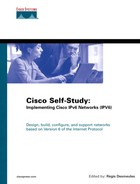Chapter 2
| 1: | For each of the fields in the following table, give the field's length and indicate whether it is used in the IPv4 header or IPv6 header.
| ||||||||||||||||||||||||||||||||||||||||||||||||||||||||||||||||||||||||||||||||||||
| A1: | Answer:
| ||||||||||||||||||||||||||||||||||||||||||||||||||||||||||||||||||||||||||||||||||||
| 2: | List the fields removed from the IPv4 header. | ||||||||||||||||||||||||||||||||||||||||||||||||||||||||||||||||||||||||||||||||||||
| A2: | Answer: Header length, Identification, Flags, Fragment Offset, Header checksum, Options, Padding | ||||||||||||||||||||||||||||||||||||||||||||||||||||||||||||||||||||||||||||||||||||
| 3: | What new field is added in the IPv6 header? | ||||||||||||||||||||||||||||||||||||||||||||||||||||||||||||||||||||||||||||||||||||
| A3: | Answer: Flow Label | ||||||||||||||||||||||||||||||||||||||||||||||||||||||||||||||||||||||||||||||||||||
| 4: | Describe the use of the Next Header field in the IPv6 header. | ||||||||||||||||||||||||||||||||||||||||||||||||||||||||||||||||||||||||||||||||||||
| A4: | Answer: The Next Header field defines the type of information following the basic IPv6 header. The type of information can be a transport-layer protocol such as TCP or UDP, or it can be an extension header. | ||||||||||||||||||||||||||||||||||||||||||||||||||||||||||||||||||||||||||||||||||||
| 5: | List the extension headers that may be placed after the basic IPv6 header, and place them in the order they must appear. | ||||||||||||||||||||||||||||||||||||||||||||||||||||||||||||||||||||||||||||||||||||
| A5: | Answer:
IPv6 header Hop-by-Hop Options header Destination Options header (if the Routing header is used) Routing header Fragment header Authentication header Encapsulating Security Payload header Destination Options header Upper-layer header (TCP, UDP, ICMPv6, ...) | ||||||||||||||||||||||||||||||||||||||||||||||||||||||||||||||||||||||||||||||||||||
| 6: | What is mandatory with UDP when used over IPv6? | ||||||||||||||||||||||||||||||||||||||||||||||||||||||||||||||||||||||||||||||||||||
| A6: | Answer: The UDP Checksum field within the UDP packet is mandatory with IPv6. This field was optional in IPv4. | ||||||||||||||||||||||||||||||||||||||||||||||||||||||||||||||||||||||||||||||||||||
| 7: | What is recommended as a mechanism for nodes in IPv6 to avoid fragmentation? | ||||||||||||||||||||||||||||||||||||||||||||||||||||||||||||||||||||||||||||||||||||
| A7: | Answer: The path MTU discovery (PMTUD) mechanism | ||||||||||||||||||||||||||||||||||||||||||||||||||||||||||||||||||||||||||||||||||||
| 8: | What are IPv6's minimum MTU and recommended minimum MTU? | ||||||||||||||||||||||||||||||||||||||||||||||||||||||||||||||||||||||||||||||||||||
| A8: | Answer: The minimum MTU in IPv6 is 1280 octets, and the recommended minimum MTU is 1500 octets. | ||||||||||||||||||||||||||||||||||||||||||||||||||||||||||||||||||||||||||||||||||||
| 9: | What are the three representations of IPv6 addresses? | ||||||||||||||||||||||||||||||||||||||||||||||||||||||||||||||||||||||||||||||||||||
| A9: | Answer:
Preferred representation (always a series of eight 16-bit hexadecimal fields) Compressed representation (successive 16-bit fields made up of 0s are replaced by a double colon; leading 0s in 16-bit fields are removed) IPv6 address with an embedded IPv4 address (used by transition mechanisms) | ||||||||||||||||||||||||||||||||||||||||||||||||||||||||||||||||||||||||||||||||||||
| 10: | Compress the following IPv6 addresses into the shortest form possible.
| ||||||||||||||||||||||||||||||||||||||||||||||||||||||||||||||||||||||||||||||||||||
| A10: | Answer:
| ||||||||||||||||||||||||||||||||||||||||||||||||||||||||||||||||||||||||||||||||||||
| 11: | Describe the IPv6 address representation for URL. | ||||||||||||||||||||||||||||||||||||||||||||||||||||||||||||||||||||||||||||||||||||
| A11: | Answer: Because the colon specifies an optional port number in a URL, the IPv6 address must be enclosed in brackets. | ||||||||||||||||||||||||||||||||||||||||||||||||||||||||||||||||||||||||||||||||||||
| 12: | List the three kinds of addresses in the IPv6 addressing architecture. | ||||||||||||||||||||||||||||||||||||||||||||||||||||||||||||||||||||||||||||||||||||
| A12: | Answer: Multicast, unicast, anycast | ||||||||||||||||||||||||||||||||||||||||||||||||||||||||||||||||||||||||||||||||||||
| 13: | For each of the following address types, find the IPv6 prefix and write the address in the compressed representation. Unspecified Loopback IPv4-compatible IPv6 Link-local Site-local Multicast Solicited-node multicast Aggregatable global unicast | ||||||||||||||||||||||||||||||||||||||||||||||||||||||||||||||||||||||||||||||||||||
| A13: | Answer:
Unspecified—:: Loopback—::1 IPv4-compatible IPv6—::/96 Link-local—FE80::/10 Site-local—FEC0::/10 Multicast—FF00::/8 Solicited-node multicast—FF02::1:FF00:0000/104 Aggregatable global unicast—2000::/3 | ||||||||||||||||||||||||||||||||||||||||||||||||||||||||||||||||||||||||||||||||||||
| 14: | What is a link-local address? | ||||||||||||||||||||||||||||||||||||||||||||||||||||||||||||||||||||||||||||||||||||
| A14: | Answer: Link-local addresses are used by nodes on a local link scope only. These addresses cannot be routed between segments. Each IPv6 node by default owns one link-local address per network interface. | ||||||||||||||||||||||||||||||||||||||||||||||||||||||||||||||||||||||||||||||||||||
| 15: | What is similar to the site-local address in IPv4? | ||||||||||||||||||||||||||||||||||||||||||||||||||||||||||||||||||||||||||||||||||||
| A15: | Answer: Site-local addresses are similar to the private addressing space in IPv4, such as 10.0.0.0/8, 172.16.0.0/12, and 192.168.0.0/16. Site-local addresses must not be routed to the IPv6 Internet. | ||||||||||||||||||||||||||||||||||||||||||||||||||||||||||||||||||||||||||||||||||||
| 16: | In the following table, list the solicited-node multicast address that corresponds to each unicast address.
| ||||||||||||||||||||||||||||||||||||||||||||||||||||||||||||||||||||||||||||||||||||
| A16: | Answer:
| ||||||||||||||||||||||||||||||||||||||||||||||||||||||||||||||||||||||||||||||||||||
| 17: | Give the length in bits of the host and site parts of an aggregatable global unicast IPv6 address. | ||||||||||||||||||||||||||||||||||||||||||||||||||||||||||||||||||||||||||||||||||||
| A17: | Answer:
Host—64-bit Site—16-bit | ||||||||||||||||||||||||||||||||||||||||||||||||||||||||||||||||||||||||||||||||||||
| 18: | What three prefixes are assigned by IANA and are available as public addresses in IPv6? | ||||||||||||||||||||||||||||||||||||||||||||||||||||||||||||||||||||||||||||||||||||
| A18: | Answer:
2001::/16—IPv6 Internet 2002::/16—6to4 transition mechanism 3ffe::/16—6bone | ||||||||||||||||||||||||||||||||||||||||||||||||||||||||||||||||||||||||||||||||||||
| 19: | What is the Cisco IOS Software command to enable IPv6 on a Cisco router? | ||||||||||||||||||||||||||||||||||||||||||||||||||||||||||||||||||||||||||||||||||||
| A19: | Answer: ipv6 unicast-routing | ||||||||||||||||||||||||||||||||||||||||||||||||||||||||||||||||||||||||||||||||||||
| 20: | What protocol ID is used for IPv6 in Ethernet frames? | ||||||||||||||||||||||||||||||||||||||||||||||||||||||||||||||||||||||||||||||||||||
| A20: | Answer: 0x86DD | ||||||||||||||||||||||||||||||||||||||||||||||||||||||||||||||||||||||||||||||||||||
| 21: | Explain how IPv6 multicast addresses are mapped over Ethernet. | ||||||||||||||||||||||||||||||||||||||||||||||||||||||||||||||||||||||||||||||||||||
| A21: | Answer: Multicast mapping over Ethernet uses the multicast Ethernet prefix to which the low-order 32-bit of the IPv6 addresses is appended. | ||||||||||||||||||||||||||||||||||||||||||||||||||||||||||||||||||||||||||||||||||||
| 22: | Generate IPv6 interface IDs (in EUI-64 format) from the following Ethernet link-layer addresses.
| ||||||||||||||||||||||||||||||||||||||||||||||||||||||||||||||||||||||||||||||||||||
| A22: | Answer:
| ||||||||||||||||||||||||||||||||||||||||||||||||||||||||||||||||||||||||||||||||||||
| 23: | What command assigns one IPv6 address to an interface using EUI-64 format? | ||||||||||||||||||||||||||||||||||||||||||||||||||||||||||||||||||||||||||||||||||||
| A23: | Answer: ipv6 address ipv6-address/prefix-length eui-64 | ||||||||||||||||||||||||||||||||||||||||||||||||||||||||||||||||||||||||||||||||||||
| 24: | What is the goal of the path MTU discovery mechanism? | ||||||||||||||||||||||||||||||||||||||||||||||||||||||||||||||||||||||||||||||||||||
| A24: | Answer: The main goal of the path MTU discovery mechanism is to find out the maximum MTU value along a path when a packet is sent. |
